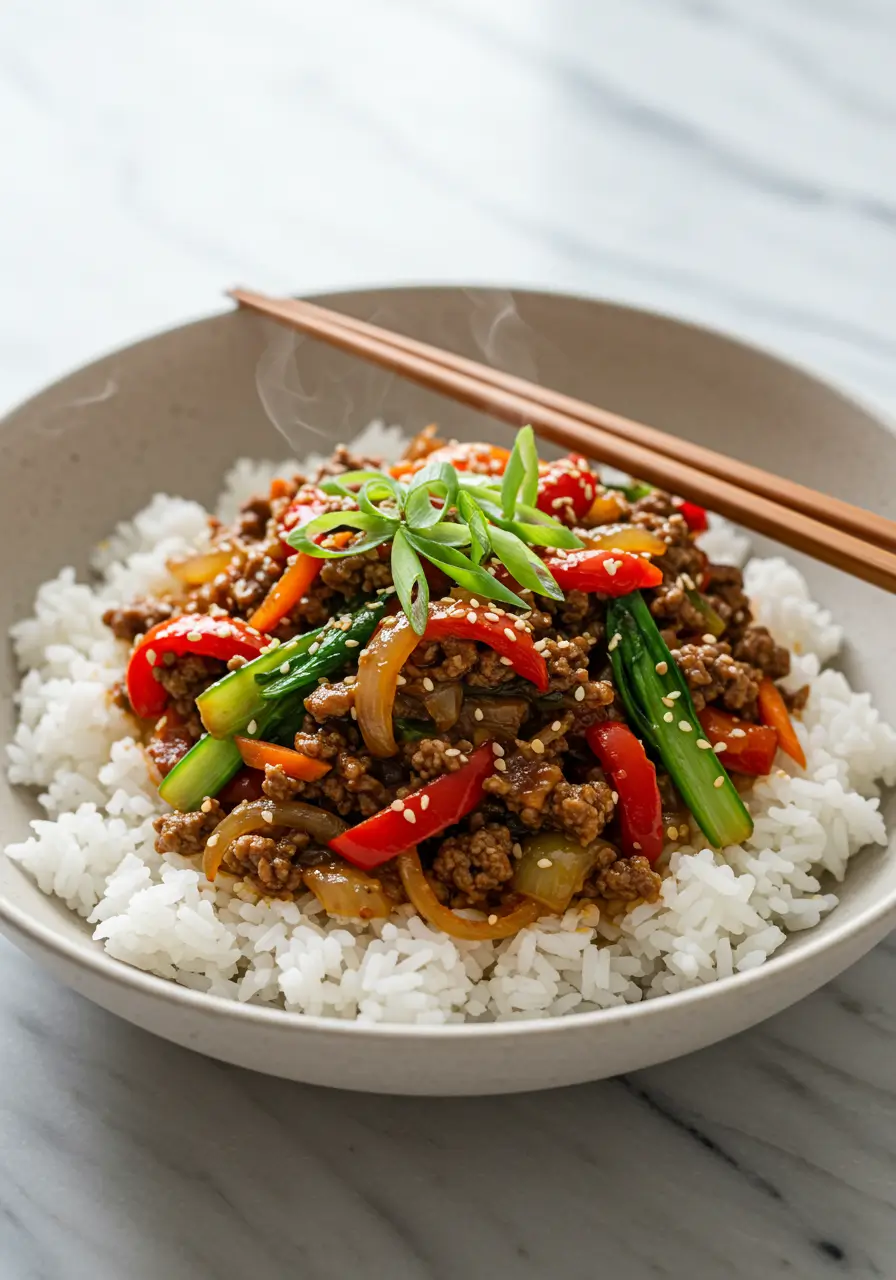Bulgogi Ground Beef Stir Fry Recipe
Did you know that switching from traditional sliced beef to bulgogi ground beef can cut your prep time by 60% while delivering the same addictive Korean BBQ flavors? In today’s fast-paced world, home cooks are discovering that ground beef bulgogi offers all the savory-sweet magic of authentic Korean barbecue without the hassle of slicing, marinating overnight, or firing up the grill. This bulgogi ground beef stir fry transforms humble ground beef into a restaurant-quality meal in just 20 minutes, making it the perfect solution for busy weeknights when you’re craving bold, umami-rich flavors.
Traditional bulgogi requires thinly sliced ribeye or sirloin and hours of marination, but this ground beef version democratizes Korean cuisine, making it accessible to anyone with basic pantry staples. The result? A perfectly caramelized, flavor-packed dish that rivals any Korean BBQ joint—ready in a fraction of the time.
Ingredients List
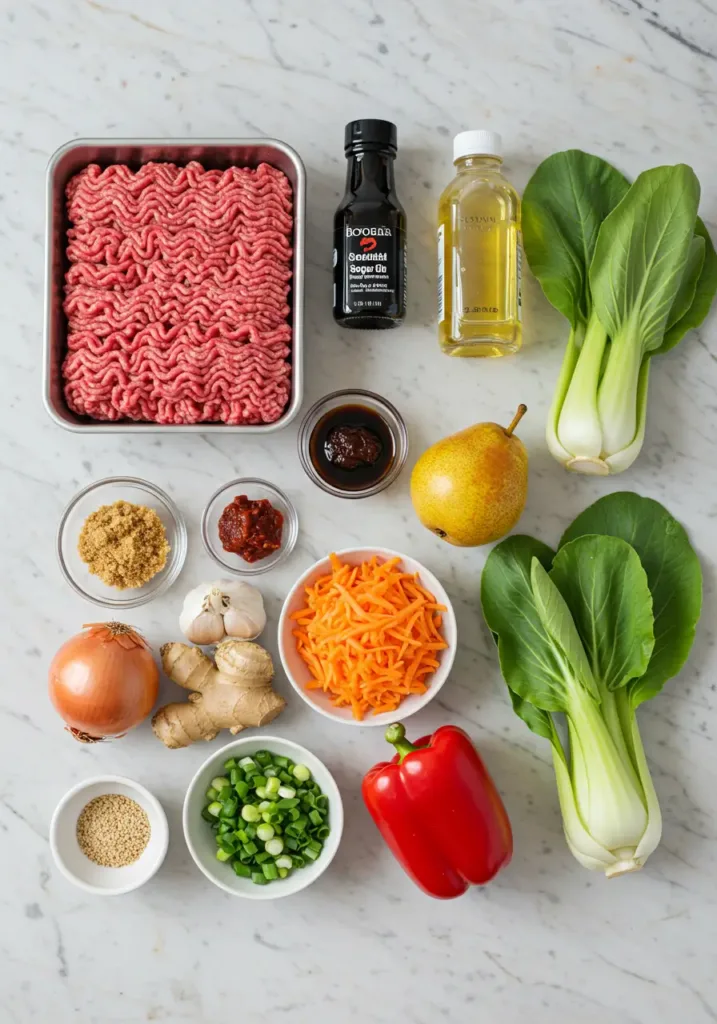
For the Bulgogi Ground Beef:
- 1 pound ground beef (80/20 blend recommended for optimal flavor and juiciness)
- Substitution: Ground turkey or chicken for a leaner option
- 3 tablespoons soy sauce (low-sodium preferred)
- Substitution: Tamari for gluten-free, coconut aminos for soy-free
- 2 tablespoons brown sugar (creates that signature caramelized crust)
- Substitution: Honey, maple syrup, or coconut sugar
- 1 tablespoon sesame oil (adds nutty depth)
- 4 cloves garlic, minced (aromatic foundation)
- 1 tablespoon fresh ginger, grated (bright, spicy warmth)
- 2 tablespoons gochujang (Korean red chili paste for heat)
- Substitution: Sriracha or red pepper flakes (less authentic but accessible)
- 1 Asian pear, grated (traditional meat tenderizer and sweetener)
- Substitution: Bosc pear, apple, or 2 tablespoons pineapple juice
- 2 green onions, sliced (fresh, crisp garnish)
- 1 tablespoon toasted sesame seeds (textural contrast)
- 1 tablespoon cooking oil (vegetable, avocado, or grapeseed)
Optional Vegetables (Adds Color & Nutrition):
- 1 medium onion, thinly sliced
- 1 cup shredded carrots
- 1 bell pepper, julienned
- 2 cups fresh spinach or baby bok choy
Timing
- Prep Time: 10 minutes
- Cook Time: 10 minutes
- Total Time: 20 minutes
This recipe delivers dinner in just 20 minutes—approximately 75% faster than traditional bulgogi recipes that require 2-4 hours of marination time. Perfect for last-minute meal planning or when unexpected guests arrive.
Servings: 4 people Difficulty Level: Easy (beginner-friendly)
Step-by-Step Instructions
Step 1: Create Your Bulgogi Marinade
In a medium bowl, whisk together the soy sauce, brown sugar, sesame oil, minced garlic, grated ginger, gochujang, and grated Asian pear until the sugar dissolves completely. The pear not only adds natural sweetness but contains enzymes that tenderize the beef while preventing it from becoming tough during high-heat cooking. This marinade should smell intensely aromatic with a perfect balance of salty, sweet, and spicy notes.
Pro Tip: Grate the pear directly over the bowl to capture all the precious juices that act as natural meat tenderizers.
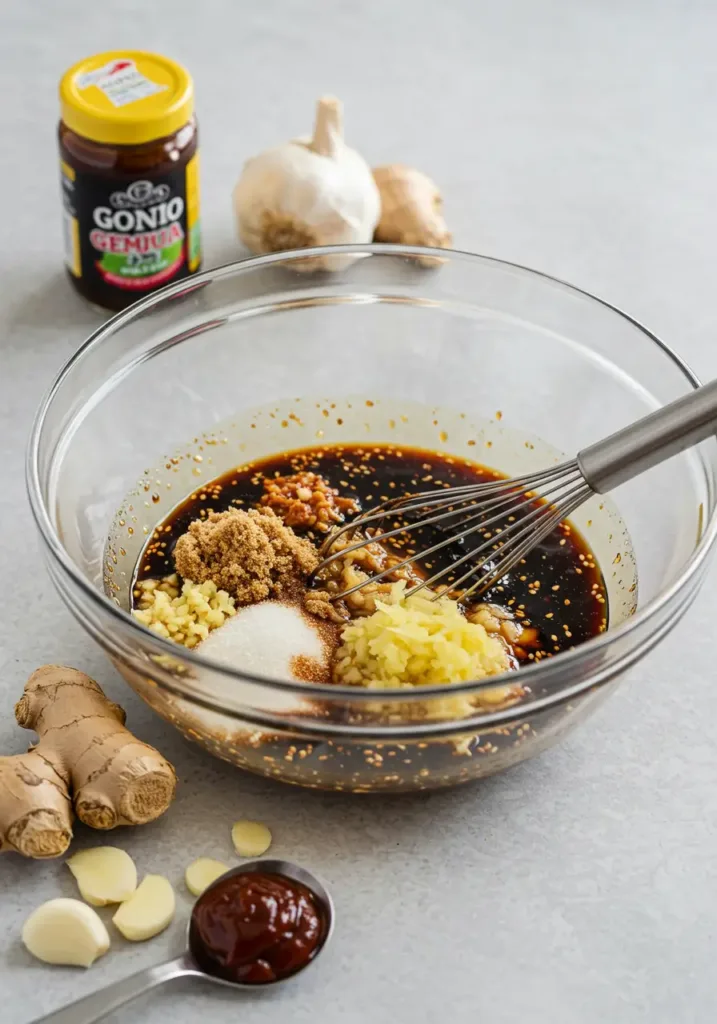
Step 2: Brown the Ground Beef
Heat a large skillet or wok over medium-high heat and add your cooking oil. Once the oil shimmers (about 30 seconds), add the ground beef. Break it apart with a wooden spoon or spatula, spreading it across the pan to maximize surface contact. Let it cook undisturbed for 2-3 minutes to develop a golden-brown crust—this caramelization is where the magic happens, creating layers of flavor through the Maillard reaction.
Pro Tip: Resist the urge to constantly stir. Letting the meat sear creates those coveted crispy edges that make bulgogi irresistible.
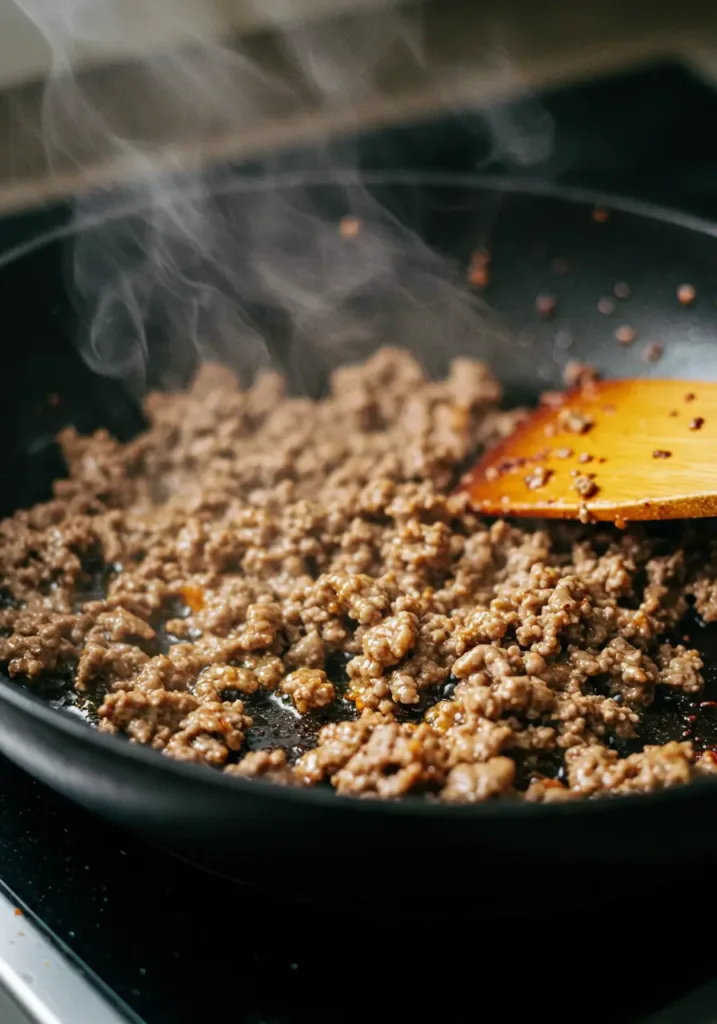
Step 3: Add Vegetables (Optional)
If using vegetables, push the browned beef to the sides of the pan and add sliced onions, carrots, and bell peppers to the center. Stir-fry for 2-3 minutes until they begin to soften but retain a slight crunch. This adds nutritional value and textural variety to your dish.
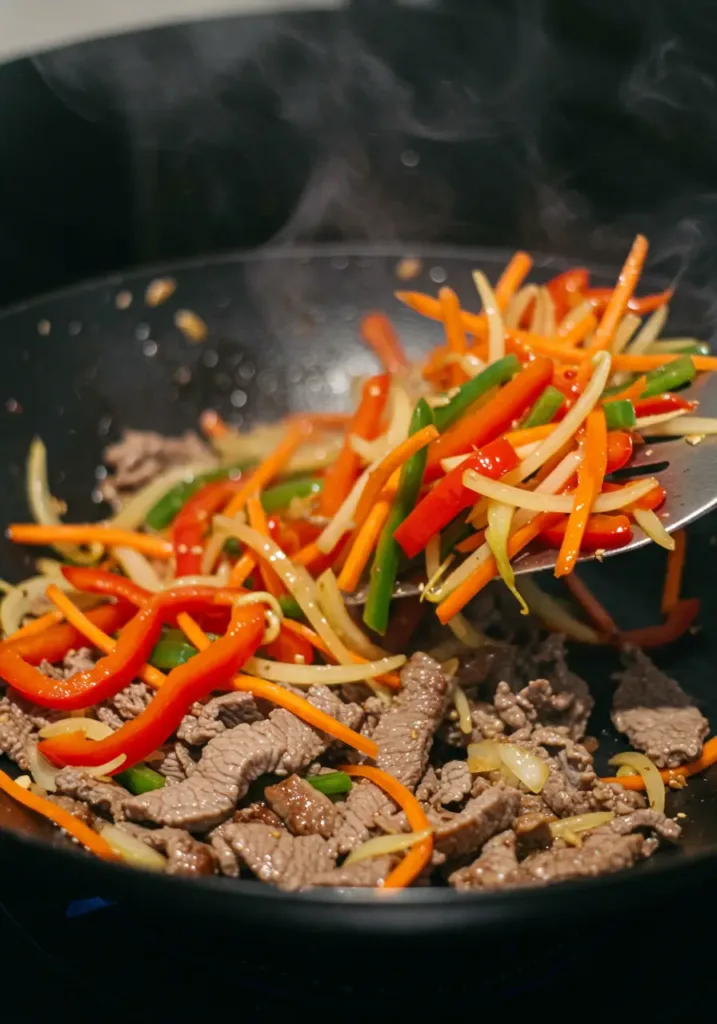
Step 4: Incorporate the Bulgogi Sauce
Pour your prepared marinade over the cooked beef and vegetables. Stir everything together, ensuring every morsel is coated in that glossy, caramelized sauce. Continue cooking for 3-4 minutes, allowing the sauce to reduce and thicken, clinging to the meat like a savory glaze. You’ll notice the sauce transforming from liquid to a sticky, concentrated coating.
Pro Tip: If your sauce seems too thick, add a tablespoon of water. Too thin? Let it simmer an extra minute.
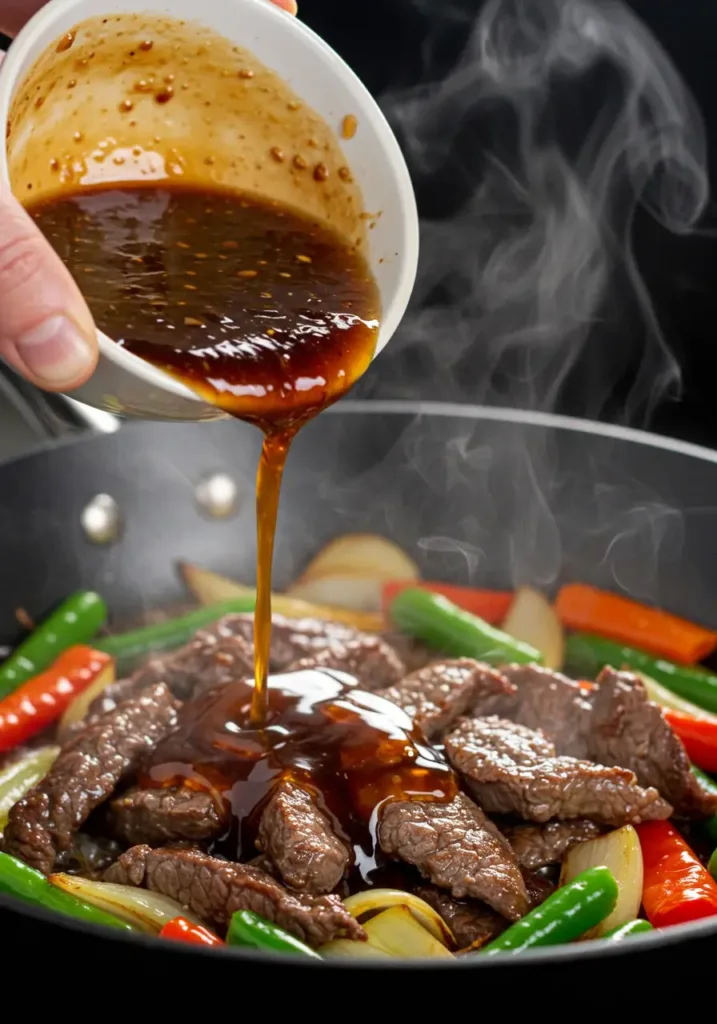
Step 5: Add Final Touches
Reduce heat to low and fold in any leafy greens like spinach or bok choy—they’ll wilt in seconds from the residual heat. Taste and adjust seasoning. Need more sweetness? Add a pinch of sugar. Want more heat? Drizzle in extra gochujang. This is your opportunity to personalize the flavor profile.
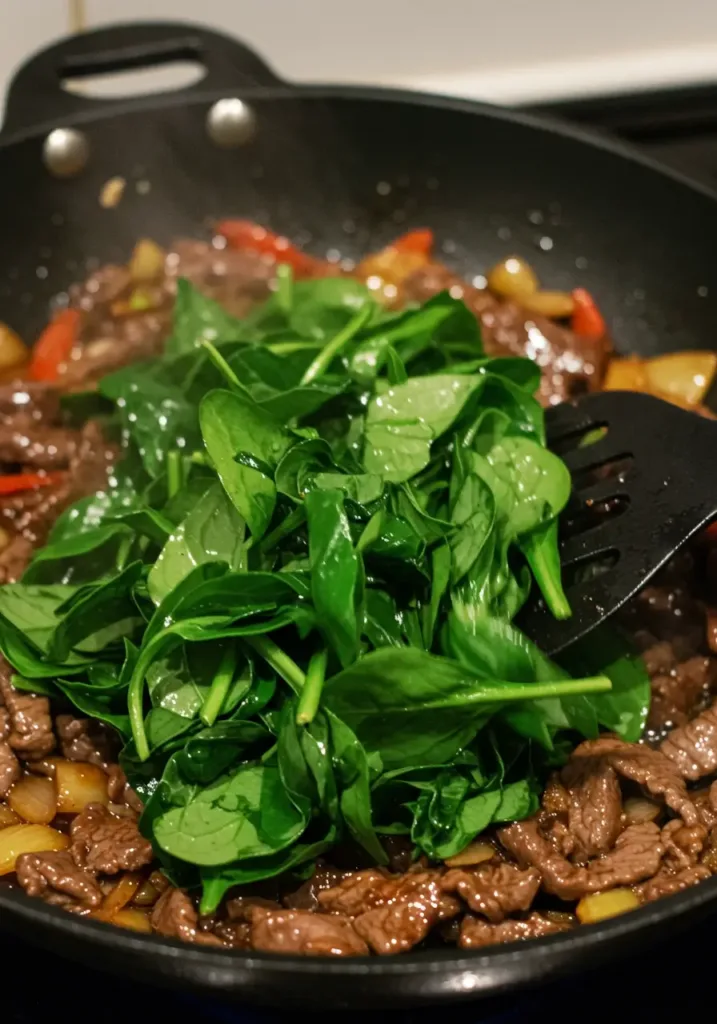
Step 6: Garnish and Serve
Remove from heat and immediately garnish with sliced green onions and toasted sesame seeds. The green onions add a fresh, sharp contrast to the rich, savory beef, while sesame seeds provide a satisfying crunch and nutty finish.
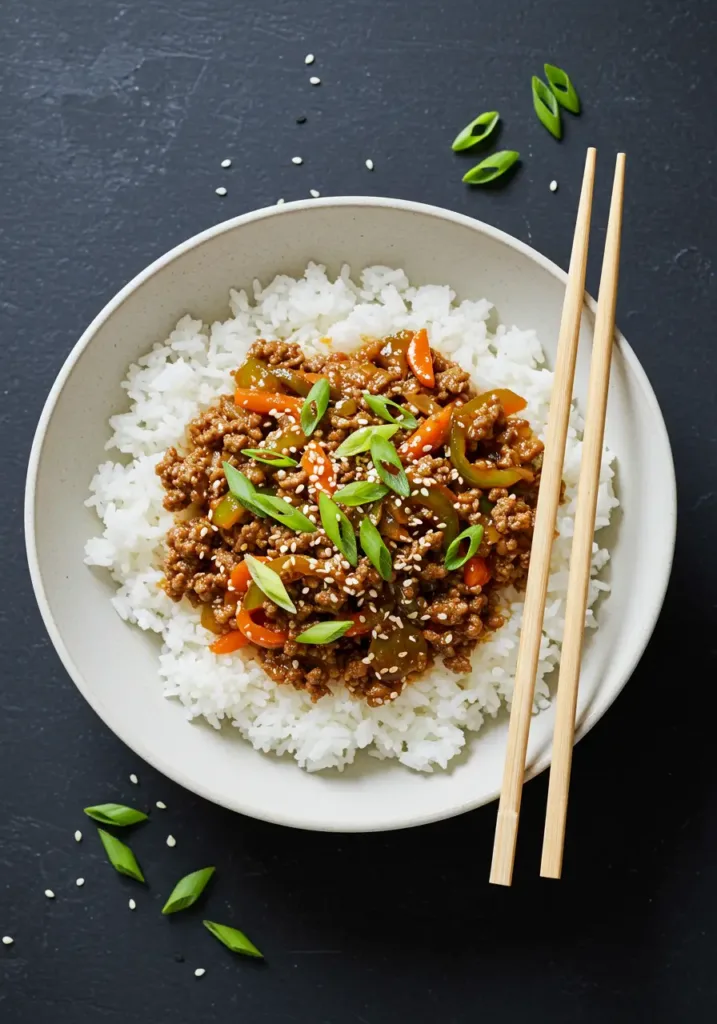
Nutritional Information
Per Serving (1/4 of recipe, approximately 1 cup):
- Calories: 394 kcal
- Protein: 22g (44% DV) – Excellent for muscle maintenance and satiety
- Total Fat: 27g (35% DV)
- Saturated Fat: 9g
- Monounsaturated Fat: 12g
- Polyunsaturated Fat: 3g
- Carbohydrates: 13g (4% DV)
- Dietary Fiber: 1g
- Sugars: 10g
- Cholesterol: 81mg (27% DV)
- Sodium: 1149mg (50% DV)
- Potassium: 510mg (11% DV)
- Iron: 2.8mg (16% DV)
Key Nutritional Highlights:
- High-quality protein source supporting muscle development
- Rich in iron, essential for oxygen transport and energy production
- Contains B vitamins (particularly B12) crucial for metabolism
- Provides selenium and zinc for immune function
Note: Nutritional values are estimates and may vary based on specific ingredients and portion sizes.
Healthier Alternatives for the Recipe
Lower-Calorie Modifications:
- Swap to 93/7 lean ground beef or ground turkey breast to reduce calories by approximately 120 per serving and cut saturated fat by 60%
- Reduce sugar by half and rely on the natural sweetness from pear—saves 24 calories per serving
- Use liquid aminos instead of soy sauce to cut sodium by 25-30%
Dietary-Specific Adaptations:
- Keto-Friendly: Replace brown sugar with erythritol or monk fruit sweetener, skip the pear
- Paleo: Use coconut aminos and coconut sugar, ensure gochujang is compliant
- Whole30: Eliminate sugar entirely, use compliant hot sauce instead of gochujang
- Vegetarian: Substitute crumbled extra-firm tofu or plant-based ground meat, maintaining the same cooking technique
- Low-Carb: Serve over cauliflower rice instead of white rice (saves 40g carbs per serving)
Nutrient-Boosting Add-Ins:
- Mushrooms: Add sliced shiitake or cremini for extra umami and vitamin D
- Kimchi: Stir in 1/2 cup for probiotic benefits and authentic Korean flair
- Extra Vegetables: Double the veggie content with zucchini, broccoli, or snap peas for increased fiber
Serving Suggestions
Classic Korean BBQ Style: Serve your bulgogi ground beef over a generous bowl of steaming white rice or nutty brown rice, accompanied by traditional Korean banchan (side dishes) like cucumber kimchi, pickled radishes, and seasoned bean sprouts.
Modern Bowl Variations:
- Bulgogi Rice Bowl: Layer over rice with a fried egg on top, drizzle with spicy mayo
- Lettuce Wraps: Serve in crisp butter lettuce cups with julienned cucumbers and carrots for a low-carb option
- Bulgogi Burrito Bowl: Combine with black beans, corn, avocado, and cilantro-lime rice for a Korean-Mexican fusion
- Noodle Bowl: Toss with udon, ramen, or rice noodles for a slurp-worthy dinner
- Loaded Nachos: Top tortilla chips with bulgogi beef, cheese, jalapeños, and sour cream
Perfect Pairings:
- Beverages: Korean soju, light beer, or sparkling water with lime
- Side Dishes: Miso soup, edamame, or a simple cucumber salad with rice vinegar
- Toppings Bar: Set out gochujang mayo, crispy fried onions, pickled ginger, and extra sesame seeds for a build-your-own experience
Meal Prep Tip: This bulgogi ground beef stays fresh for 4-5 days refrigerated, making it perfect for weekly meal prep. Pack it with separate containers of rice and vegetables for grab-and-go lunches.
Common Mistakes to Avoid
1. Using Lean Ground Beef (95/5 or 90/10) While seemingly healthier, extra-lean ground beef becomes dry and crumbly during high-heat stir-frying. The 80/20 blend provides necessary fat for moisture and flavor development.
2. Overcrowding the Pan Packing too much meat into your skillet creates steam instead of sear. If doubling the recipe, cook in two batches or use two pans simultaneously for that essential caramelized crust.
3. Adding Sauce Too Early Introducing the marinade before the beef browns prevents proper caramelization. Always brown the meat first, then add sauce to create layers of flavor—this is the difference between good and extraordinary bulgogi.
4. Skipping the Asian Pear The pear isn’t just for sweetness—its enzymes naturally tenderize the meat and add complexity. Without it, your bulgogi lacks that authentic depth. If unavailable, don’t skip the substitution.
5. Over-Stirring During Cooking Constant stirring prevents the beef from developing those crispy, caramelized edges that make bulgogi special. Patience is key—let it sit and sizzle.
6. Not Tasting for Balance Korean cuisine is all about harmony between sweet, salty, spicy, and umami. Always taste before serving and adjust seasoning. Too salty? Add more sugar. Too sweet? Add soy sauce or a splash of rice vinegar.
7. Using Cold Ingredients Room temperature ingredients cook more evenly. Take your ground beef out of the refrigerator 15 minutes before cooking for optimal results.
Storing Tips for the Recipe
Refrigeration:
- Storage Duration: 4-5 days in an airtight container
- Best Practice: Let the bulgogi cool completely before refrigerating to prevent condensation and sogginess
- Container Choice: Use glass containers to prevent staining and odor absorption
- Separation Strategy: Store the beef separately from rice and vegetables to maintain optimal texture when reheating
Freezing:
- Storage Duration: Up to 3 months in freezer-safe containers or heavy-duty freezer bags
- Portioning Tip: Freeze in individual serving sizes for easy defrosting
- Flash Freeze Method: Spread bulgogi on a parchment-lined baking sheet, freeze until solid (2 hours), then transfer to bags—this prevents clumping
- Labeling: Always date your containers and include reheating instructions
Reheating Guidelines:
- Stovetop Method (Best): Reheat in a skillet over medium heat with a splash of water or broth for 5-7 minutes, stirring occasionally
- Microwave Method: Heat in 60-second intervals, stirring between, until warmed through (2-3 minutes total)
- Avoid: Overcooking during reheating, which can make the beef tough and dry
Meal Prep Strategies:
- Prepare the marinade up to 1 week in advance and store in a jar
- Pre-chop vegetables and store in separate containers for ultra-quick assembly
- Cook double batches and freeze half for future emergency dinners
- Marinated raw ground beef can be refrigerated for 24 hours before cooking
Conclusion
This bulgogi ground beef stir fry revolutionizes Korean BBQ by delivering authentic flavors in just 20 minutes. The savory-sweet marinade, caramelized beef, and customizable serving options make it perfect for weeknight dinners, meal prep, or entertaining. With its high protein content and adaptable nature, this recipe satisfies various dietary needs while maintaining that irresistible Korean BBQ taste everyone loves.
Ready to transform your dinner routine? Try this bulgogi ground beef recipe tonight and experience why it’s becoming a weeknight staple in homes worldwide. Don’t forget to leave a review sharing your experience, drop a comment with your favorite serving style, or subscribe to our blog for more quick, authentic international recipes that make cooking exciting again!
FAQs
Q: Can I make bulgogi ground beef without gochujang? A: Absolutely! While gochujang provides authentic Korean heat and fermented depth, you can substitute sriracha, sambal oelek, or even red pepper flakes mixed with a bit of miso paste. The flavor profile will differ slightly, but you’ll still achieve a delicious, spicy-sweet result.
Q: Why use ground beef instead of sliced beef for bulgogi? A: Ground beef bulgogi offers several advantages: no time-consuming slicing, no marination period required, faster cooking time, and lower cost. It’s perfect for beginners and busy households while delivering similar flavors to traditional bulgogi. The ground texture also absorbs the marinade more readily.
Q: Can I prepare this bulgogi recipe ahead of time? A: Yes! You can prepare the marinade up to 1 week ahead and refrigerate it. Mix raw ground beef with the marinade and refrigerate for up to 24 hours before cooking for even deeper flavor penetration. Cooked bulgogi stores well for 4-5 days, making it excellent for meal prep.
Q: What’s the best way to serve bulgogi ground beef for guests? A: Create an interactive “bulgogi bar” with the beef as the centerpiece, surrounded by various bases (white rice, cauliflower rice, lettuce cups), toppings (fried eggs, kimchi, pickled vegetables), and sauces (gochujang mayo, sesame dressing). This lets guests customize their meals and makes entertaining effortless.
Q: Is bulgogi ground beef spicy? A: The spice level is moderate and completely customizable. Gochujang provides warmth rather than intense heat. For mild versions, reduce gochujang to 1 tablespoon or omit entirely. For spicier results, double the gochujang or add fresh sliced chili peppers during cooking.
Q: Can I use this recipe for meal prep bowls? A: Absolutely! Bulgogi ground beef is ideal for meal prep. Cook a large batch, portion into containers with rice and vegetables, and refrigerate for up to 5 days. The flavors actually intensify over time. Reheat gently with a splash of water to maintain moisture and texture.
Q: What cut of ground beef works best? A: An 80/20 ground beef blend (80% lean, 20% fat) provides optimal flavor, moisture, and texture. The fat content prevents dryness during high-heat cooking and enhances the caramelization process. Leaner options like 90/10 work but may result in a drier final product.
Q: How do I prevent my bulgogi from becoming too salty? A: Use low-sodium soy sauce and taste your marinade before adding to the beef. Remember that the sauce reduces and concentrates during cooking, intensifying saltiness. If your finished bulgogi is too salty, balance it with a squeeze of fresh lime juice or serve with plain rice to absorb excess sodium.

